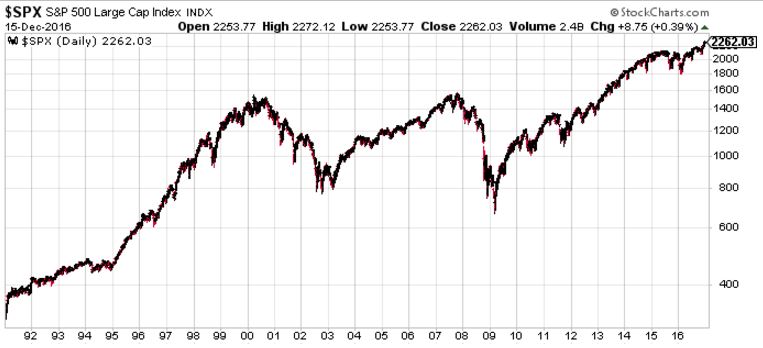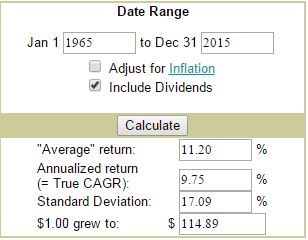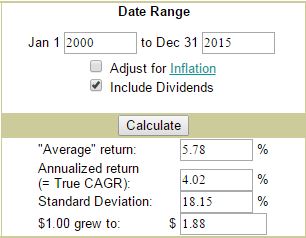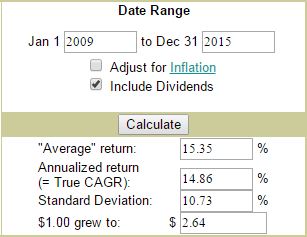By Billy and Akaisha Kaderli
Special to the Financial Independence Hub
As 2016 comes to a close, we thought we would look back financially to where we started this adventure, from January of 1991. The chart below shows the ascent of the S&P 500 Index over our 26 years of retirement.
On our retirement date of January 14, 1991, the S&P 500 index closed at 312.49. It has recently closed at 2262, making roughly an 8% annual gain plus a couple per cent counting dividends. Hard to imagine, right? With all of the market ups and downs, global turmoil, governments coming and going, businesses expanding and failing, and still producing roughly a 10% annual return.
But is this really a one-off period and not the norm?
Using a calculator, we can see that the S&P 500 returns for the last 100 years, including dividends, is 10.03%.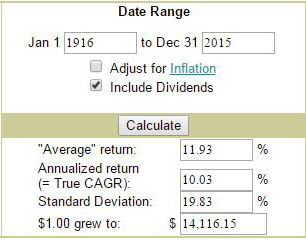
And recalculating for the last 50 years, total return is slightly less at 9.75%. Clearly there is a trend here.
Does this mean that every year you invest you are going to have a 10% return? No!
But what it does tell us is that over longer time periods the return on your investment is handsomely rewarded.
However, if we look at the returns since the year 2000 they have been sub par at a annualized rate of just 4.02%.
And finally, since the financial crisis in 2009, the S&P 500 Index produced a total return of 14.86% including dividends.
Investing is not rocket science and does not need to be complicated.
Getting your house in order for retirement or financial independence is not that difficult. Many investment professionals, journalists, and commentators seem to complicate the issue to the point that even we can’t understand it. Safe withdrawal rates, stocks, bonds, balanced funds, commodities, options, laddered portfolios, annuities, offshore accounts, hedge funds, life insurance … are you kidding? No wonder some people are confused and scared!
What’s a person to do?
First, you need to recognize your needs. Let’s be realistic here. How much are you spending now? Not how much do you make a year, but how much are you paying out? With today’s computer online tools and spreadsheets, this is a very easy task to compute.
The longer you keep track of current consumption, the more confident you’ll become of your future spending habits.
Once you know your expenditures per year, take a look at where that money is going. If it’s to pay credit card bills or other consumer debt, you need to pay that off first. It’s fine to use credit cards as long as you completely pay off your balance monthly. And stay out of debt. I know this is not easy, but it’s your future, and the money you were paying in interest can now be invested.
With your debts paid off, you can commit to financial independence. Analysts say a guideline of 25 times your annual capital outlay should be enough to sustain your current lifestyle. With the data you’ve collected in your chart, you can easily calculate a target amount.
It’s really that simple.
Once you reach your invested net worth goal you can withdraw 4% on an annual basis to cover your living expenses. For example, you earn 10% annually on your investments, you take out 4% to live on, leaving 6% to cover inflation and to be reinvested. This is how you create a sustainable money machine.
How do you get there?
Only you know what your risk tolerance is, but have some faith in yourself. Learn about no-load mutual funds, and low cost ETFs (Exchange Traded Funds), and become your own financial advisor. You can do this. Remember, it’s not how complicated your investments are, it’s how well they perform and whether you understand them.
You’ve managed your finances for 40 to 50 years already, right? Maybe you weren’t perfect, but you’re still here! So do you not think that you can manage your finances for the next 40 to 50 years? Even though you will no longer have that paycheck coming on Friday, there are many ways to pay yourself each week. You could simply write yourself a check each Friday, or have automatic withdrawals transferred into your checking account.
So start today. Get your consumer debts paid off completely, educate yourself on investment opportunities that you understand, and take control of your future. Dream of financial independence, and let that motivate you.
You can do it — we did!
 Billy and Akaisha Kaderli are recognized retirement experts and internationally published authors on topics of finance, medical tourism and world travel. With the wealth of information they share on their award winning website RetireEarlyLifestyle.com, they have been helping people achieve their own retirement dreams since 1991. They wrote the popular books, The Adventurer’s Guide to Early Retirement and Your Retirement Dream IS Possible available on their website bookstore or on Amazon.com.
Billy and Akaisha Kaderli are recognized retirement experts and internationally published authors on topics of finance, medical tourism and world travel. With the wealth of information they share on their award winning website RetireEarlyLifestyle.com, they have been helping people achieve their own retirement dreams since 1991. They wrote the popular books, The Adventurer’s Guide to Early Retirement and Your Retirement Dream IS Possible available on their website bookstore or on Amazon.com.

